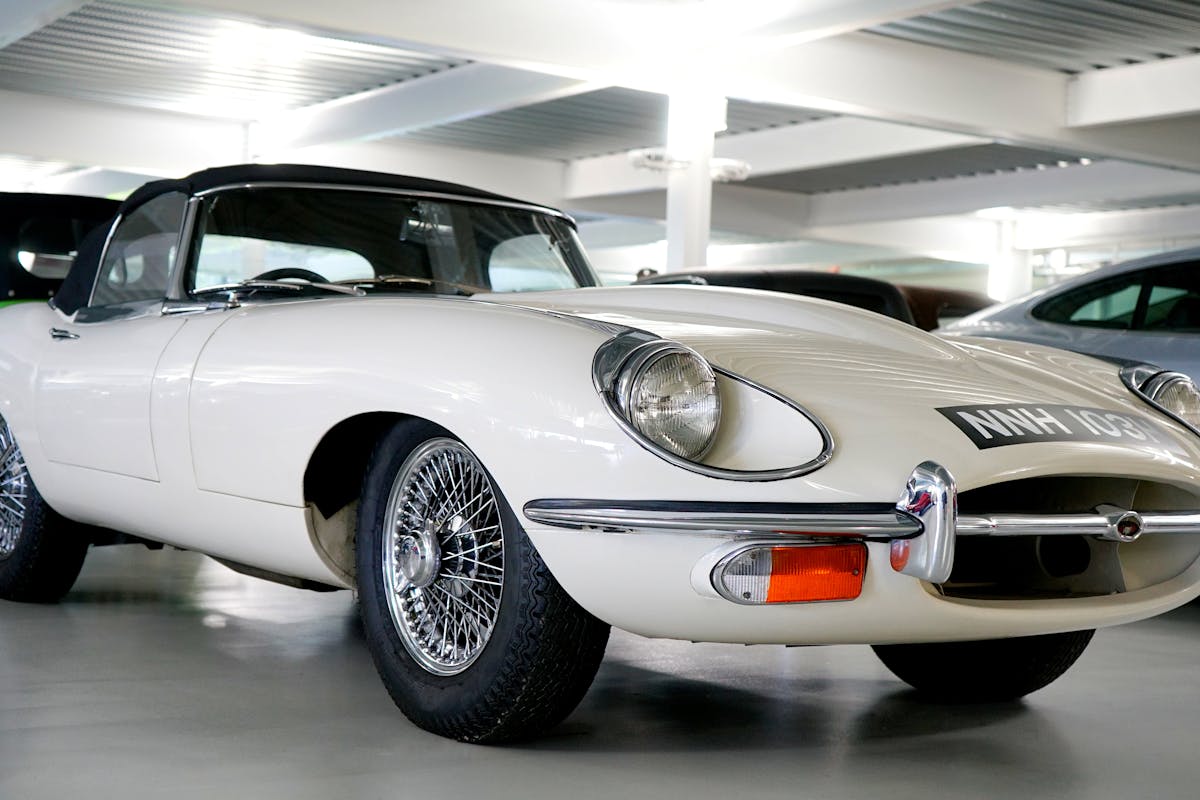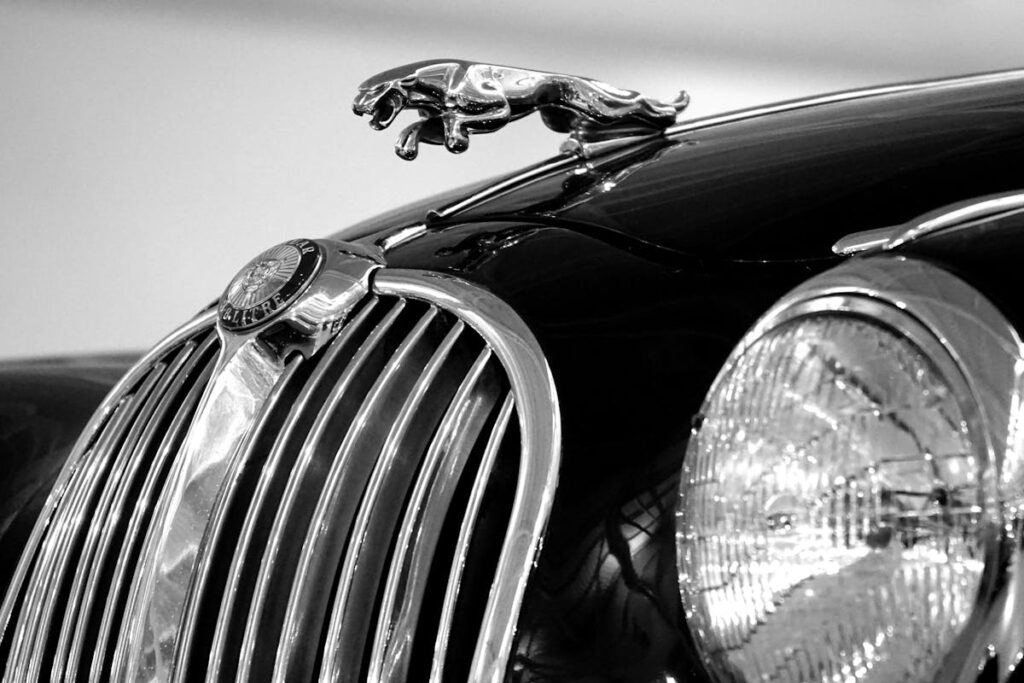The value of a classic Jaguar, a symbol of British automotive excellence, is a topic of great debate among car enthusiasts and collectors. A myriad of factors, such as rarity, condition, historical significance, restoration costs, and market trends, all contribute to the monetary worth of these vintage beauties. Yet, quantifying the worth of such iconic models like the coveted E-Type or the more common XJ6 is no simple task. Is there a definitive methodology to ascertain the real value of a classic Jaguar? Let’s explore further.
History of Jaguar Automobiles
Emerging from the ashes of the Second World War, the Jaguar brand was born – a symbol of British ingenuity and craftsmanship. With a rich Jaguar heritage defined by luxury craftsmanship and engineering innovations, the brand immediately made a mark on the automotive industry. The iconic designs of Jaguar models, from the XK120 to the E-Type, bear evidence to this vision of style, speed, and sophistication.
Jaguar’s performance legacy was forged not only in the world of luxury vehicles but also on the racetrack. The brand’s racing history is punctuated with numerous victories, including a triumphant streak at Le Mans in the 1950s, solidifying its reputation for speed and handling.
Moreover, Jaguar’s cultural impact extends beyond its automotive milestones. The brand has been featured in numerous films, television shows, and literature, often associated with a certain level of prestige and elegance. The XK120, for instance, was James Dean’s car of choice, while the E-Type was famously described by Enzo Ferrari as “the most beautiful car ever made”. These instances encapsulate Jaguar’s enduring appeal and the significance of its contribution to the automotive world.
Understanding Classic Car Valuation
To accurately ascertain the worth of a classic Jaguar, it is critical to grasp the nuances of classic car valuation. There are numerous factors that can impact a car’s value, ranging from its original specifications to its current condition. Additionally, appraising a classic Jaguar requires a keen understanding of the marque’s specific attributes, its historical significance, and its appeal to collectors.
Factors Affecting Car Value
A myriad of factors come into play when determining the value of a classic Jaguar. One crucial factor is the restoration costs associated with returning the vehicle to its original condition. These costs can include labor charges, parts expenses, and the intricacy of the restoration process. Restoring a classic Jaguar is an art as much as it is a science, and the quality of the restoration work can greatly impact its final valuation.
The second factor lies in collector demand. Classic Jaguars are highly sought after by car enthusiasts and collectors, and the demand can vary depending on the rarity, condition, and historical significance of the model. The higher the demand, the higher the potential value. Collector demand also ties into market trends. As with any commodity, the value of classic cars fluctuates depending on the market’s current state and future predictions.
While these factors play an essential role, it is worth noting that the value of a classic Jaguar is not solely determined by these elements. Other factors, such as provenance, originality, and documentation, can also influence a car’s value and will be considered in a thorough valuation.
Appraising Classic Jaguars
In the domain of classic car appraisals, understanding the process and intricacies can be intimidating, especially when it comes to discerning the value of a classic Jaguar. The valuation is influenced by several factors, including the car’s originality, its condition, and the rarity of the model. However, two essential elements to take into account are the engine specifications and restoration costs.
Engine specifications hold substantial weight in the valuation process. The Jaguar’s engine, whether it’s an XK120’s 3.4L straight-six or an E-Type’s V12, can greatly impact the value. Original engines in excellent running condition are highly desirable, and rare engine types can fetch a premium.
On the other hand, restoration costs also play a significant role. If a Jaguar requires extensive restoration, potential buyers may subtract these expected expenses from their offering price. The cost to restore a classic Jaguar can vary greatly, depending on the model and the extent of the work needed. However, a well-executed, professional restoration can markedly enhance the car’s value.
Importance of Model and Year
When considering the worth of a classic Jaguar, the model and year of the vehicle play an essential role. Variations between models can have a significant impact on value, with certain historic release years holding notable prestige and consequently, a higher market price. In addition, the depreciation factor, which varies from year to year, also contributes to the overall valuation of these esteemed vehicles.
Model Variations and Values
Delving into the intricacies of classic Jaguar values, it becomes evident that the model and year of manufacture play a pivotal role in determining the worth of these esteemed vehicles. The valuation process is complex and multi-faceted, with model comparisons and price fluctuations contributing considerably to the overall value.
In many cases, the model is the primary determinant of a classic Jaguar’s value. For instance, the Jaguar E-Type, produced from 1961 to 1975, has consistently high values due to its iconic status and limited production numbers. In contrast, the Jaguar XJ6, although still a respected model, typically commands a lower price due to its more extended production run and higher initial quantities.
Price fluctuations are also a critical consideration when evaluating the worth of a classic Jaguar. Prices can be influenced by factors such as market trends, the condition of the vehicle, and the rarity of the specific model and year. For instance, an original 1961 E-Type in excellent condition can command a considerably higher price than a later model in poor condition.

Notable Historic Year Releases
Appreciating the significance of model and year in the classic Jaguar market necessitates a closer look at some notable historic year releases. Among the most iconic designs is the 1961 E-Type, a car that revolutionized the sports car industry with its streamlined form, high performance, and relative affordability. Its legendary performances at the Le Mans 24-Hour Race cemented its status in automotive history.
Another key release is the 1968 XJ6, a luxury saloon that expertly combined refinement, comfort, and speed. Its advanced features and elegant design set a new standard for executive cars, making it a sought-after model in today’s classic car market.
The 1975 XJS, launched as a successor to the E-Type, likewise deserves mention. Despite initial mixed reviews, it evolved into a respected grand tourer with its smooth ride and powerful V12 engine. It’s now a classic representative of 1970s British automotive design.
These notable historic year releases illustrate the importance of model and year in determining a classic Jaguar’s worth. Each model’s unique combination of design, performance, and historical significance contributes to its value, emphasizing the need for potential buyers to carefully consider these factors.
Depreciation Factors by Year
The value of a classic Jaguar is considerably influenced by the model and year, as these factors contribute to its depreciation rate. A deeper understanding of depreciation trends can provide valuable insights into the car’s potential worth. Accordingly, year comparisons play a pivotal role in determining the depreciation rate of each model.
Jaguars from the 1960s, for instance, often command high values due to their iconic status and rarity. In contrast, models from the 1980s experience steeper depreciation due to oversupply and less demand. Moreover, certain milestone years, such as the introduction of significant design changes or technological advancements, can impact depreciation rates. For example, the 1961 Jaguar E-Type, a revolutionary model for its time, generally holds its value better than other models.
However, it is crucial to note that depreciation isn’t linear. A classic Jaguar may experience a rapid decline in its initial years, followed by a plateau and potentially an increase in value as it becomes a sought-after vintage model. This phenomenon underscores the importance of model and year in understanding the potential value of a classic Jaguar. To summarize, a thorough evaluation that considers these factors can greatly aid in estimating an accurate worth.
Assessing the Condition
A notable number of factors come into play when evaluating the condition of a classic Jaguar. The interior condition and the exterior finish are two essential elements that greatly impact the worth of this classic vehicle.
The interior condition reflects the general care the vehicle has received over the years. It includes the condition of the seats, dashboard, carpets, and other interior details. A well-maintained interior is a clear indication of a car that has been cared for and not exposed to excessive wear and tear. It also reveals a lot about the owner’s commitment to preserving the vehicle’s originality.
The exterior finish, on the other hand, speaks volumes about the car’s history. A flawless finish suggests the car has been stored properly, avoiding harsh weather conditions that can degrade paint and cause rust. It also indicates that the car has been driven responsibly, avoiding accidents and damages that can notably depreciate its value.
Rarity Factor in Valuation
Often underestimated, the rarity factor plays a crucial role in valuing a classic Jaguar. The scarcity of a particular model, its production numbers, and its uniqueness greatly contribute to its market price. This is where rarity assessments and collectible demand intersect.
To appreciate the rarity factor in valuation, consider these four points:
- Limited Production Runs: Classic Jaguars with low production numbers tend to have a higher value due to scarcity.
- Unique Features: Distinctive elements such as special body styles, engine types, or original colors can increase a car’s rarity and, as a result, its value.
- Historical Significance: Jaguars associated with important events, or that have been owned by notable individuals, often command a premium.
- Survival Rate: The fewer models that have survived in original or restored condition, the rarer they are. This scarcity can drive up demand and value.
Impact of Market Trends
Understanding market trends is an essential part of determining the value of a classic Jaguar. Market trends provide a snapshot of the prevailing economic climate and can greatly influence the prices of classic cars, including Jaguars. These trends are shaped by a myriad of factors, such as economic conditions, investor sentiment, and collector demand.
Market fluctuations, in particular, play a vital role in shaping these trends. A stable market often fosters a steady growth in value for classic cars, including Jaguars. Conversely, a volatile market could see prices fluctuating wildly, reflecting the uncertainty and risk that it brings. This underscores the importance of tracking market trends when attempting to ascertain the value of a classic Jaguar.
The other key element that shapes market trends and, by implication, the value of a classic Jaguar is collector demand. A surge in demand often leads to an increase in value, while a decrease can lead to a drop in prices. Hence, understanding and responding to collector demand is paramount to accurately determining the value of a classic Jaguar. To sum up, market trends, shaped by market fluctuations and collector demand, are essential in determining the value of a classic Jaguar.
Case Studies of Classic Jaguars
How can the value of a classic Jaguar be best demonstrated? Through real-world case studies, we can gain valuable collector insights into the true worth of these vehicles. Let’s explore four such studies:
- 1961 Jaguar E-Type: This classic vehicle underwent extensive Jaguar restoration, enhancing its value. Initially purchased for $45,000, the post-restoration value skyrocketed to $165,000.
- 1955 Jaguar D-Type: A pristine model was found in a private collection. Its untouched, all-original condition led to an auction price of a staggering $21.7 million, demonstrating the value of preserving originality.
- 1966 Jaguar XJ13: Considered a rarity due to its limited production, a well-maintained model fetched an impressive $9 million at auction.
- 1959 Jaguar XK150: A good condition model with regular maintenance sold for $130,000, illustrating the consistent demand for this model.
These scenarios highlight the significant role of Jaguar restoration and collector insights in determining the worth of classic Jaguars. They show the potential return on investment, the value of originality, the impact of rarity, and the steady demand for certain models. Consequently, the value of a classic Jaguar is not just in its age or model, but in the overall quality, originality, and provenance.
Tips for Selling Your Classic Jaguar
Having established the significant potential worth of classic Jaguars, it is essential to contemplate the strategies that can facilitate a successful sale. The first step is to develop a thorough preparation checklist. This includes ensuring the car is in excellent condition. The engine should be running smoothly, the bodywork should be rust-free, and the interior should be clean and well-maintained. If needed, invest in professional detailing to enhance the car’s visual appeal.
Next, compile all relevant documentation such as maintenance records, registration documents, and any historical information about the vehicle. This not only substantiates the car’s authenticity but also builds trust with potential buyers.
Equally important are effective marketing strategies. High-quality photos and detailed descriptions are essential for online listings. Additionally, consider showcasing your classic Jaguar at car shows and auctions, where it will be seen by a concentrated audience of potential buyers. Utilizing social media platforms and classic car forums can also broaden your reach.
Frequently Asked Questions
What Insurance Options Are Available for Classic Jaguars?
Classic Jaguars can be insured through classic car insurance policies, offering extensive vintage vehicle coverage. This caters to the unique needs of these vehicles, including agreed value coverage, spare parts coverage, and flexible usage limits.
How Does the Maintenance Cost of a Classic Jaguar Compare to Other Classic Cars?
The maintenance cost of a classic Jaguar can be higher than other classic cars due to the potential for extensive restoration expenses and the limited availability of authentic parts, making upkeep a significant consideration.
Where Can I Find Original Parts for Classic Jaguars?
Locating original parts for classic Jaguars can be challenging. However, restoration resources are available online and through specialized sourcing suppliers. It’s essential to verify the authenticity and condition of these parts before purchase.
Are Classic Jaguars Suitable for Daily Use or Only for Collection Purposes?
Classic Jaguars, while adding a unique aesthetic and driving experience, may not offer daily reliability due to age-related wear and tear. They are generally viewed as collectibles rather than everyday vehicles.
How Can I Verify the Authenticity of a Classic Jaguar?
Authenticity of a classic Jaguar can be verified through documentation verification including original sale papers and maintenance records. Additionally, an expert appraisal can provide an assessment of the vehicle’s originality and condition.

